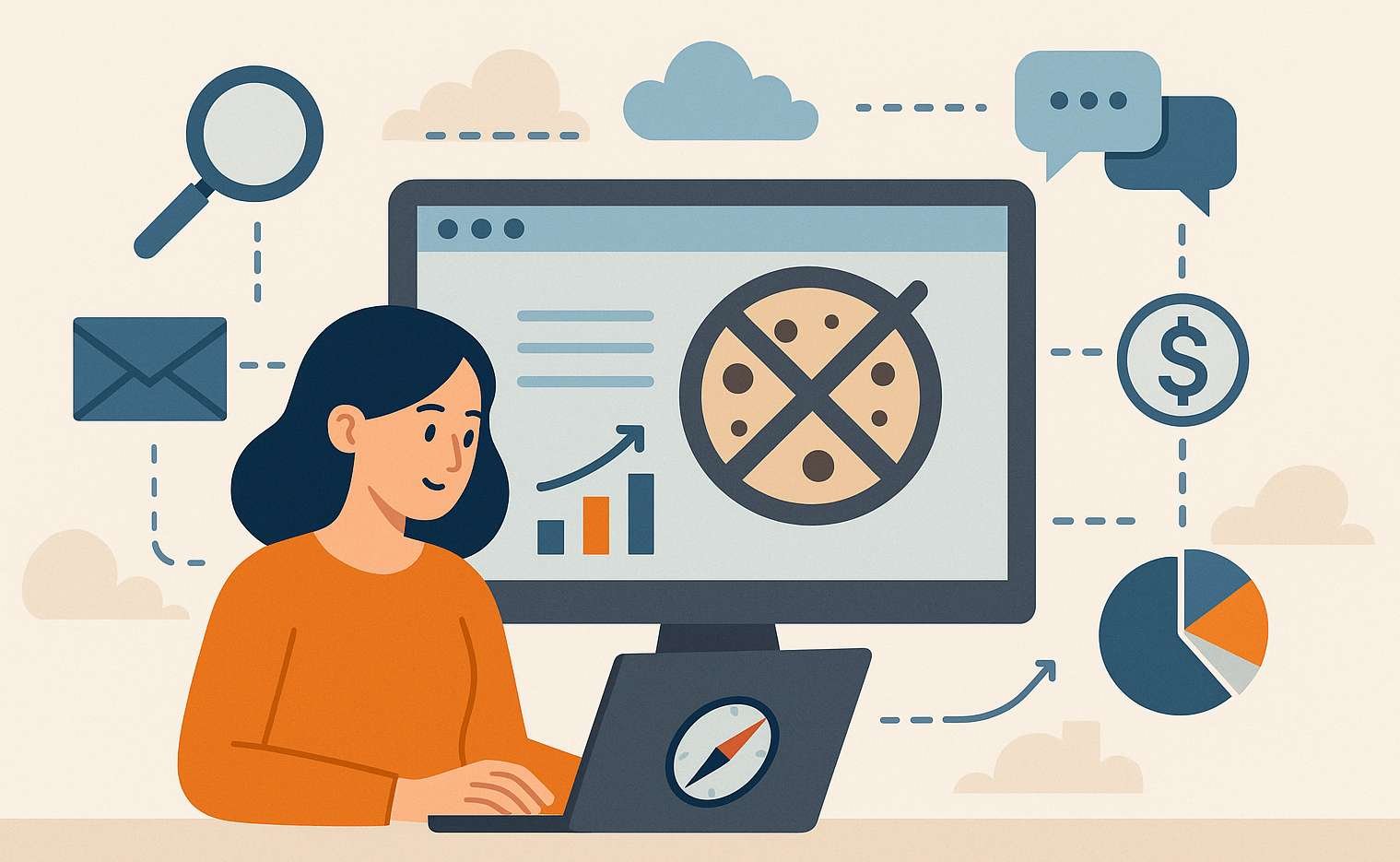Fundamental Principles of Digital Marketing Strategies
Digital marketing is an integral part of any modern company. It encompasses a variety of online activities such as search engine optimization, paid advertising, social media marketing and email marketing, all designed to reach a highly targeted customer base. Some of the key benefits of these activities include: increased brand awareness, better customer relationships and lower operating costs.
By interacting directly with customers, it is possible to group them based on specific characteristics determined by their interests or behavior. This leads to far less wastage in advertising spend, greater response rates and the opportunity to convert customers and generate sales. It also makes it easier to raise brand awareness where interest levels are particularly low.
Understanding Cookies and Their Role
Cookies are text files sent by a Web browser and stored on the visitor’s device. Their purpose is to remember information about the visitor, such as preferences and login states, making the browsing experience more personalized and efficient. There are two key types of cookies. First-party cookies are created by the website the user is visiting. Third-party cookies are created by other sites that control the advertisements appearing on the visited site. These cookies allow marketers and platforms to identify individuals and target and optimize advertisements based on their online behavior.
When marketers pay for advertising space on a website, they also need to pay ad providers for the ‘place’ where the ad is served. By using cookies to analyze individuals’ online browsing behavior, the ad provider and the ad buyer can decide on the best and the most effective space for a given company’s advertisement. Further, by analyzing the individuals’ online browsing behavior, the ad provider and the ad buyer can decide on the right advertisements to serve, at the right time, and to the right individuals.
Impact of Cookie-less Browsing
Cookies are small files stored in a user’s browser by visited websites. They help marketers keep track of customer preferences and behaviour to offer a personalised experience for each user. Cookies serve various functions such as enabling websites to remember shopping cart items, saving user preferences, gathering consent for compliance, measuring ad impressions, serving targeted ads, detecting fraud, and attributing conversions.
Since everybody’s focus in digital marketing shifted to better privacy management, the push for less cookie tracking is apparent. Browsers like Safari and Firefox already support cookie blocking and have moved towards a cookieless future. Google, planned for mid-2023, will end support for third-party cookies in the Chrome browser as well. As a consequence, marketers must reassess their strategies.
Shifting to Privacy-First Marketing
Due to growing privacy concerns, new legislation and increasing constraints imposed by major ad providers, digital marketers are rapidly running out of options and increasingly forced to seek solutions and alternatives. These developments mean that digital marketers will no longer be able to rely on cookies for tracking and targeting audiences or behavioural retargeting digital ads—commodities for the past decade. Consequently, digital marketing strategies must shift toward a privacy-first approach that respects the privacy of customers and audiences.
Privacy-first marketing is a broad term that Elders refers to as a “concept that implies the freedom for marketing to operate effectively in a manner that is also respectful of the customer’s privacy.” Marketing that exceeds what customers want or expect risks being seen as a negative experience. The protection of individual privacy is not a new notion, but the evolving ecosystem suggests that a privacy-first mindset is critical even if it does not generate the most profit. General Data Protection Regulation, enacted in 2018, established new rules concerning individual privacy, and other countries are following managed by numerous jurisdictions—California is only the latest.
First-Party Data Collection Strategies
Collecting first-party data is an effective way to overcome the challenges of cookie-less browsing. By building consent-driven, transparent relationships with customers, marketers can directly capture essential information such as names, birthdays, and ZIP codes. Loyal customers who recognize the value brands provide on platforms like Instagram, Facebook, and TikTok are often eager to share these details. First-party data collection not only strengthens consumer relationships but also underpins other privacy-compliant marketing tactics such as email outreach and contextual advertising.
A variety of methods are available to collect first-party data. Loyalty programs, for example, incentivize customers by offering early access, discounts, and exclusive perks in exchange for contact information. Online sweepstakes and contests similarly encourage data sharing by providing opportunities to win prizes. Interactive mechanisms like gated content—requiring an email address to access special downloads—or chatbot-initiated quizzes can engage users while gathering useful personal details. These strategies reflect a commitment to consumer privacy and highlight a broader shift toward creating value in exchange for data.
Building Customer Relationships
Long-term relationships with customers are the foundation for business growth. They support repeat purchases, create brand loyalty, and increase customer lifetime value. A robust loyalty program encourages customers to return and remain loyal to the brand. Marketing strategies must focus on building long-lasting bonds with customers and offer more value from each customer interaction. Improving customer retention and nurturing leads, new or existing, are crucial marketing goals. Significant resources are dedicated to customer acquisition, and business growth depends on securing new customers.
Establishing a connection between the business and potential or returning customers makes them feel appreciated and valued. An customer-centric approach leads to more effective marketing decisions. Email addresses are essential for building the first-party database, driving customer engagement, and cementing relationships. Since email marketing does not rely on cookies, it ensures continuous brand engagement even when relying less on third-party cookies. It creates a channel for direct communication with consumers, offering timely information about new product launches, discounts, sales campaigns, and more. This encourages customers to visit the store or e-commerce site and complete purchases.
Utilizing Email Marketing
Email marketing remains an effective tool for marketers in a cookie-less environment. First-party data, including email addresses obtained from customers, permits segmentation and personalization without interest-based tracking. By collecting email addresses from customers or subscribers, marketers can build a dedicated audience for targeted campaigns. To maximize effectiveness, email campaigns should be segmented according to interests, preferences, and behaviors to ensure relevant messages. Crafting personalized and engaging content, such as exclusive offers, newsletters, and event invitations, enhances brand affinity and encourages conversions.
Re-engaging dormant subscribers is another key tactic. Sending targeted communications designed to awaken interest can reactivate these segments and boost overall engagement rates. As with all collection points, the key is transparency in how the data will be used, coupled with an easy opt-out process to meet necessary consent requirements. The inherent “first party” nature of the channel helps comply with data privacy regulations regarding remote identification such as GDPR. Because it involves direct communication, marketers retain full control, mitigating reliance on third parties and potential vulnerabilities associated with the loss of cookies.
Leveraging Contextual Advertising
Cookies are often used to improve advertising on the internet. Targeted advertisements used to be the norm, but what happens when cookies disappear? Marketers will face problems related to cross-browser, cross-device, and cross-session tracking and retargeting and will have to reply more on first party channels and advertising. With privacy-first marketing in place, the consumers will become the king again. Brands will need first party data, better email marketing, and the ability to develop direct relationships with their customers. If brands are unable to generate relationships with their customers, their advertising efforts have to be able to do it. Contextual advertising will become more and more important to generating relevant experiences.
Contextual advertising uses the content of a web page to place an ad in proximity to relevant and complementary material. By placing related advertising in the context of the platform or page, contextual ad targeting can deliver ads relevant to readers, resulting in higher engagement and the potential for a better user experience. Contextual targeting can be used synonymously with keyword targeting or placement targeting to define ad targeting that is specifically related to the content or category of a particular placement on the platform (like a website). Rather than serving ads based on who the audience is, ads are served based on the ads’ relevance to the content on the page that the displaying audience is consuming. Contextual ad targeting can be used in social media, digital display, and video advertising. Targeting ensures it is the right audience within that relevant context.
Understanding Contextual Targeting
Contextual targeting enables advertisers to place their ads on websites related to their products or services without collecting personal information about the user. By examining the web page’s category, content, keywords, and location, advertisers can present ads associated with the page’s subject. This approach aligns with privacy-first marketing and caters to cookie-less customers. Research indicates that 71% of shoppers appreciate ads that align with their interests and shopping needs, highlighting the relevance of contextual advertising.
Contextual ads commence from a keyword list derived from extensive research related to the area or product of interest. Analyzing the keywords used on each page allows advertisers to select the specific websites and webpages for their ads (for instance, targeting travel books within the category tourism). Consequently, contextual targeting requires research and understanding of the subject, as well as knowledge of the market and audience. When performed correctly, it can prove highly effective.
Creating Relevant Content
Content marketing remains one of the most effective marketing strategies even in a cookie-less world. Without cookies, marketers will need to dig deeper when researching relevant keywords and phrases. Not only do marketers need to find out what exactly their customers are searching for, they will also want to discover when they are conducting these searches and whether or not they are doing it on a mobile device. Using Google Analytics can help marketers track this information.
Creating content that is relevant and timely will help drive more traffic, not only to digital sites but also to physical stores. These insightful Google Analytics are even more important if a marketing team must operate with a tight budget. Marketers will want to carry out keyword research that brings in the best traffic during the right time for their store. If search traffic for a significant keyword suddenly drops, it might be better to put the focus on another word that is trending up.
Exploring Alternative Tracking Solutions
While a cookie-less world brings changes to the way we track user behavior and measure advertising campaign success, it doesn’t necessarily represent the end. Other approaches include employing server-side, first-party data tracking or web telemetry, using unique identifiers, or relying on social signals.
Server-side tracking reroutes data collection from a user’s browser to the web server controlling the website. This method offers enhanced data privacy and security, and customers can opt-in for tracking by logging in to the website. Going server-side for analytics and measurement can keep first-party data centralized and enable deep integration with existing dashboards and customer relationship management tools.
Server-Side Tracking
Server-side tracking is often promoted as a way to prevent data loss when browsing is cookie-less. It involves sending data directly from the server instead of the browser, thereby making it less likely to be blocked by browser trackers. However, in practice, customers are not necessarily any more comfortable sharing their data when it is tracked on the server side. In addition, a good content delivery network will deliver content from a server close to the user to enhance website speed and improve user experience.
Since slow load times will negatively affect mobile SEO rankings and reduce the amount of online traffic, Google emphasizes Shifting to Privacy-First Marketing. They remind website owners to: Improve page experiences Ensure your site is secure Secure user data Remove intrusive ads Make your website mobile-friendly Google’s clear message is the website should focus on users, not the company.
Using Unique Identifiers
Cookies have been one of the biggest headaches in digital marketing—and they never got a full pass by website visitors, either. They’re stuffed full of user information and negotiating that data handoff can take up valuable time before your visitors ever get to what they came for. Cookies have traditionally been used to track site visits for ads, site analysis, customer experience, preference sharing, targeting, follow-up ads and the like. Users can choose to have cookies enabled on their phones; when they don’t, marketers need to be able to pivot. Using a unique identifier is one effective alternative. Anonymized customer datasets shared across publishers and advertisers can reveal marketing impact while ensuring user privacy; identity can be culled from contextual data such as location and time of day. First-party data relates to any information a brand collects from its sales channels. It is generally considered zero- or first-party data in the marketing ecosystem. Second-party data is the first-party data of a trusted partner. Third-party data are datasets aggregated and sold to advertisers.
Embracing Privacy Regulations
Digital marketing has seen a rise in privacy regulations such as the California Consumer Privacy Act (CCPA), the General Data Protection Regulation (GDPR), and the Brazilian General Data Protection Law (LGPD). Non-compliance can result in fines ranging from thousands to billions of dollars. Marketers must therefore prioritize strategies that respect user privacy to ensure compliance and avoid penalties.
Increasing consumer fears regarding privacy have also led to a rise in the use of ad blockers, which is particularly concerning given the global rise in advertising expenditures. To encourage consumers to disable these blockers on a website, marketers can offer entry discounts or exclusive deals in exchange for the user’s contact information, making the advertising experience more valuable. More generally, marketers may consider making their first interaction with consumers valuable and educational to protect their reputations and foster loyalty.
Enhancing User Experience
In the absence of cookies, a fast website may be the best way to get and keep visitor attention. Website speed not only reduces bounce rate, it also increases visitor engagement, improving click-through rates and conversion rates. As a result, search engines rank faster sites higher, which means more organic traffic and conversion rate optimization, all which are essential foundation for a marketing strategy in a cookie-less world.
The website should also be optimized for mobile phone users because more than half of Internet users use mobile devices to find services and make shopping decisions; however, many mobiles users still encounter frustrating mobile versions of websites. Mobile-optimized websites have better SEO rankings and implicit audience segmentation. For instance, or a restaurant website, the mobile audience is mostly people looking up addresses and opening times or trying to book a table rather than seeing the menu and daily specials.
Improving Website Speed
Improve website speed by optimizing and minimizing the use of CSS and JavaScript files. Remove unnecessary or unused files, which can reduce the number of HTTP requests required when loading the page. This results in a faster load time and improves user experience across different devices and locations. Considering that Google primarily uses mobile-first indexing, it is crucial to design websites that are fast and responsive on mobile devices. A mobile-responsive website with quick loading times offers significant benefits in terms of search engine optimization (SEO) and can positively impact conversions.
A responsive design also ensures the website is adaptable to all mobile devices, regardless of screen size or dimensions. Another effective approach to enhance website performance is server-side tracking, which shifts data collection from the client to the server side. This method not only improves control over the data collected but also simplifies integration with existing customer databases and external software.
Optimizing Mobile Experience
Optimization for mobile devices is an extremely important aspect of web browsing and digital marketing. Statistics suggest that nearly 59% of all online visits in the USA originate from mobile devices. On a global scale, estimates indicate that 63.4% of internet traffic emanates from mobile devices. These percentages will likely continue to climb as mobile phones become more user-friendly and affordable. Indeed, in many places around the world, a mobile phone in a family’s possession represents their only connection to the digital world. Therefore, providing a smooth experience at this point of contact is essential.
Enabling mobile users with a faster and more accessible website experience is critical because internet service providers worldwide continue to limit bandwidth in an effort to control infrastructure costs. With the increasing costs associated with browsing the web, consumers will demand that businesses provide faster sites that answer their questions instantaneously. Additionally, mobile phones typically suffer from small screen sizes, limited battery life, slower processors, and relies on less-efficient batteries. For this reason, it is crucial to ensure that browsing on a mobile site consumes fewer resources in terms of power and memory. When a site neglects to optimize for these practical considerations, users are more likely not to return.
Utilizing Social Media Effectively
Social media has become an indispensable tool for marketers in the cookie-less era. Engaging with followers on Facebook, LinkedIn, Twitter, YouTube, TikTok, Instagram, and emerging platforms like Mastodon encourages dialogue and builds anticipation around new products and events. Responding promptly to comments and inquiries fosters a sense of community, while integrating user-generated content can establish advocates who promote the brand organically, thereby increasing reach.
Strategic creation of consistent, high-quality social content drives website traffic, generates leads, and nurtures business relationships. Identifying the ideal demographic for each platform ensures optimized engagement; for instance, Instagram and TikTok appeal predominantly to Generation Z and Millennials, whereas Facebook and Twitter attract an older cohort. Facebook remains the most versatile channel, offering diverse targeting capabilities irrespective of demographic. Complementing social video shares with a video podcast broadens the audience, leveraging the popularity of podcasts to maintain visibility during periods of social content hiatus.
Engagement Strategies
Encouraging customer engagement and generating leads should be top digital marketing objectives. Engaged customers are more likely to make repeat purchases, consider costly upsells, and promote products and services on the internet. Customer engagement minimizes churn rate and increases customer lifetime value. Similarly, lead generation motivates prospective customers to inquire or make a purchase and creates an expanded database for future marketing campaigns.
Engagement can be nurtured through such approaches as email marketing, contextual advertising, relevant and continuously updated content, social media, influencer marketing, and mobile optimization. Email marketing has the advantage of being a permission-based communication medium through which businesses contact recipients who have willingly subscribed to their newsletters or have been ascribed to an otherwises “first-party” source. Creative, clearly positioned, and personalized newsletters help funnel interested subscribers into the sales pipeline. Contextual advertising differentiates itself from behavioral advertising by targeting prospective customers based on keywords or topic-related landing pages rather than personal profile data. Keywords are also used in a Search Engine Optimization-driven content marketing strategy that involves the creation of new, up-to-date, responsive, and engaging content on a regular basis.
Content Creation
In an environment where information is everywhere and consumers rely on Google for most of their searches, content marketing provides great benefits. Businesses create content that helps customers and prospects connect with a brand, develop confidence and trust, and even make educated decisions. This content is typically published online, on a website or blog, which brands control with no fear of changes being made to the content, the messaging, or presentation.
However, content creation is labor-intensive and demands effort and dedication. Although the results may not be immediate, they can be significant if the content is well thought out, organized, and executed.
Investing in SEO and Content Marketing
When consumers shut down or block ad tracking cookies it can be a frustrating process for brands who have to adjust their marketing strategy as ad platforms use that information to help you reach highly targeted users. Turning to search engine optimization (SEO) and content strategy can be a better way to increase organic website visits.
By conducting simple keyword research, brands can find what users are already searching for organically, as well as what kinds of questions they have about their product or service, giving some great insight into the kinds of content to produce for their target audience.
Keyword Research Techniques
Keyword research is paramount for enhancing SEO and directing organic traffic. It identifies search phrases customers use, providing insights into market demand, search intent, and keyword popularity. “Search intent” refers to the probable purpose behind a search query, such as gathering information, making a purchase, visiting a particular webpage, or downloading content. For example, the keyword “best keyword research tools in 2024” indicates an informational intent.
These insights enable marketers to pinpoint relevant keywords that align with users’ search intentions and content needs, thereby optimizing search engine rankings and providing value. Keyword research involves: keyword analysis, which assesses competitive and semantic relationships; keyword mapping, which assigns appropriate keywords to distinct webpages; and keyword strategy, which determines keyword prioritization and necessary content creation to meet campaign objectives.
Content Strategy Development
Creating relevant content is at the heart of modern marketing. Search engine algorithms, for example, are designed to make user searches more precise in Google Search. Keywords and content should be prepared in such a way that they match the search intent of the user and direct the visitor to a landing page that addresses their needs.
Displaying content that meets the needs of the visitor ensures the relevance of the page and thus also helps in ranking better and higher in search engine results. The creation of content relevant to the visitor contributes significantly to executing marketing activities effectively without using cookies.
The Role of Influencer Marketing
Influencer marketing has emerged as a valuable approach in the cookie-less era of digital advertising. Brands collaborate with popular social media figures to promote products and services leveraging the influencers’ loyal online audiences. This approach taps into targeted segments without relying on intrusion of personal data or advanced tracking technologies. Influencer marketing enables advertisers to access communities that align with the campaign goals, improve brand sentiment by linking products to trusted online personas, and drive conversions through authentic product recommendations. It also helps generate first-party data by encouraging interested consumers to visit brand-owned websites or sign up for newsletters.
Websites like ShareRocket help brands identify influencer partners using data-driven approaches based on industry category, campaign type, location, language, audience demographics, engagement rates, follower-count, and other key performance indicators. Carefully selected influencers can create content that resonates with niche target markets and complies with privacy regulations. By combining influencer marketing with other techniques such as email marketing, contextual advertising, and search engine optimisation, companies can effectively optimise campaign results despite limitations imposed by cookie-less browsers.
Finding the Right Influencers
Influencer marketing, long a popular strategy for reaching customers, takes on new relevance in a world without cookies. As the cookies that precisely target individuals disappear, brands look to people who already have the attention of their potential customers—the influencers. Working with influencers in the appropriate niche—and whose audience mirrors the company’s—is a source of coordinated content able to build interest and awareness.
Moreover, clients appreciate authentic experiences, which influencers authentically sharing stories and testimonials provide. These creators typically reach broad bases of followers, many of whom are actively browsing online. As a result, their promotions get a great deal of potential exposure that remains highly targeted.
Building Partnerships
The end of third-party cookies is ushering in game-changing dynamics for digital marketing partnerships. Marketers and companies will no longer be able to pit their data against that of their partners, the buying group, or marketplace. Instead, the focus will move toward creating partnerships where trust is paramount, giving marketers access to the data they need to supercharge campaigns.
Collaboration can take many forms, and businesses spend a lot of time and effort researching potential partners and trying to figure out how to build a mutually rewarding relationship. Marketers can optimize partnerships by offering something interesting to their partners and reaching out to their own list of companies with sufficient scale to make a difference.
Analytics and Measurement in a Cookie-less Environment
Many markers measure the success or failure of their digital marketing activity by analyzing data collected from cookies. As cookies fade from the contemporary marketing scene, marketers must identify new KPIs that disclose a campaign’s health. Marketers should also question their understanding of attribution and examine models that automate analyses in the public-cloud.
A key challenge when identity is unavailable relates to the statistical principles behind the allocation of credit for an outcome or event. Marketers must adapt attribution models when personal data is inaccessible. Public-cloud analytics services can provide automated attribution insights without relying on cookie data.
Key Performance Indicators (KPIs)
Marketers use KPIs to measure the performance of a marketing effort. Setting the right goals for a specific campaign and using data-driven insights can make all the difference when picking KPIs. While various KPI types exist, some are more relevant during the post-cookie era.
Key Performance Indicators can be arranged to fit different levels of a sales funnel. The levels include awareness, engagement, conversion, and delight. At the awareness level, KPIs include active app users, brand awareness, branded search volume, total reach, impressions, and mobile app installs. Engagement KPIs focus on analysing followers gained, comments, likes, app engagement, shares, update subscriptions, fan growth, Google My Business engagement, and reviews and ratings. At the conversion level, relevant KPIs comprise average ticket size, bounce rates, click-through rates, email and SMS responses, new leads, conversion rates, order values, and sales since the last campaign. Finally, the delight level aims to measure customer happiness through average resolution time, cancellation rate, churn rate, customer lifetime value, deal size, low-response accounts, net promoter score (NPS), and open rate.
Attribution Models
Attribution models play a central role for businesses when evaluating the performance and the efficiency of their marketing campaigns and strategies. Attribution refers to the process of assigning value or credit to the individual touchpoints involved in the customer journey that leads to conversion. Attribution models help marketers determine how to allocate their budget and resources in a way that achieves their goals and objectives. Marketers can select from a range of attribution models—such as last-click, first-click, linear, time decay, position-based, or custom models—that reflect their unique preferences and circumstances. Measurement in a cookie-less environment can be accomplished through simple metrics such as conversion rate, by examining the source or method through which visitors came to the website, or by implementing more advanced techniques such as multi-touch attribution, which considers all interaction points a user has with the brand before conversion. However, multi-touch attribution indicates a greater dependence on cookies and users’ behavioral data during their browsing sessions, which is not a viable option for digital marketers in a cookie-less browsing world.
Future Trends in Digital Marketing
Digital marketing strategies continue to evolve as new privacy regulations emerge and browsers phase out third-party cookies. Artificial intelligence (AI) and machine learning are increasingly integrated into automation and personalization tools, enabling marketers to offer tailored customer experiences at scale. Large language models support content creation and conversational marketing efforts, enhancing engagement and efficiency.
Looking ahead, cookies are expected to become totally obsolete, leading marketers to adapt their measurement approaches and embrace privacy-first strategies. Businesses that act promptly to comply with regulations and safeguard consumer trust will ultimately gain a competitive advantage in an increasingly consumer-conscious environment.
Artificial Intelligence and Automation
Artificial Intelligence (AI) and automation boast the power to markedly enhance digital marketing efforts. AI-powered chatbots, for instance, promptly respond to customer inquiries and provide personalized product recommendations, thereby boosting conversion rates and customer satisfaction. Additionally, AI can analyze vast swaths of data and identify patterns—such as discerning demographics and behaviors—to enhance audience targeting. This technology also anticipates future trends and customer preferences, enabling marketers to optimize campaigns for better performance and a higher return on investment (ROI).
Automation streamlines numerous marketing facets, including A/B testing, keyword research, email segmentation, ads management, and scheduling automated messages. It offers myriad benefits, such as lower operational costs, reduced human error, improved campaign management, increased efficiency, and optimized customer engagement. AI and automation also empower marketers to efficiently conduct repetitive and data-intensive tasks, liberating them to channel creativity and resourcefulness into other areas. Ultimately, the integration of these technologies fosters more effective and scalable marketing operations.
Emerging Technologies
Numerous emerging technologies are reshaping the digital marketing landscape. Artificial Intelligence enables targeted advertising by allowing marketers to evaluate large datasets and predict customer behavior. Automation minimizes human intervention, facilitating the operation of numerous campaign variations simultaneously. Augmented Reality supports immersive experiences that increase customer engagement. The Internet of Things allows marketers to access detailed customer profiles in real time and deliver relevant messages through in-store digital signage. Voice Search Optimization is evolving rapidly, demanding the creation of specific content to respond to voice queries, thus providing customers with a more satisfactory user experience.
Google is no longer developing new features for Universal Analytics and encourages users to migrate data to Google Analytics 4 (GA4). Unlike Universal Analytics, GA4 supports both cookies and cookieless tracking with help of the Measurement Protocol, which allows the sending of hits to Google Analytics from other environments such as a server program.
Case Studies of Successful Cookie-less Marketing
Digital marketing without cookies remains feasible. Despite challenges arising from cookie-less browsing, strategic planning enables successful marketing. A few approaches exemplify effective execution.
First-party data supports loyalty creation. Building customer relationships is pivotal. To this end, routines such as sending exclusive offers, providing tailored updates, and inviting feedback bolster engagement. Email marketing represents a privacy-first instrument for customer connection, content dissemination, and promotion. Automated onboarding campaigns, personalized birthday messages, and re-engagement sequences exemplify best practice. Likewise, context-focused tactics prove valuable. Advertising congruent with page content aligns with user interests through subjects and semantic analysis; designated categories produce targeted campaigns. Google AdWords utilizes listed keywords, refined by match types, location, device, language, and negative terms. Automating such content curation promotes consistent relevance.
The substitution of server-side tracking is advisable, alongside tracking user activity via unique identifiers. Automated privacy management tools underpin these methods. Compliance with regulations, notably those in Europe and Canada, undergirds all aforementioned facets. Lastly, enhancement of user experience through optimized website speed and mobile accessibility remains integral. Case studies often augment such insights.
Challenges and Solutions
The web is going cookie-less, and marketers need to rethink their digital marketing strategies. Recent announcements from Apple, Mozilla, and Google show a shift toward blocking or restricting third-party cookies in their browsers. Although building a privacy-first marketing strategy can seem like a challenge, this transformation allows tighter relationships with customers through increased trust and transparency. Marketers can continue using data-driven marketing by focusing on first-party data, contextual advertising, and alternative tracking solutions.
Cookies facilitate ad targeting, conversion tracking, website personalization, A, B, and multivariate testing, and automatic ad-bid optimization. Without cookies, marketers might encounter two main problems: loss of detailed audience information and challenges in attributing conversions to specific customers, devices, or campaigns. These issues complicate channel optimization, bid adjustment, and audience targeting. By concentrating on first-party data collection, contextual targeting, compliance with privacy regulations, and enhanced user experience, marketers can address these challenges across all stages of the marketing funnel.
Best Practices for Digital Marketers
As the use of cookies continues to fade, marketers need to implement privacy-first, customer-centric digital marketing strategies. One of the most important considerations is to avoid relying solely on cookies for marketing. Instead, investing in first-party data collection and falling back on contextual targeting tactics will provide an advantage. Behind every effective digital marketing strategy is a strong foundation for first-party data—the targeting gold mine. Forming loyalty loops and building customer relationships ensures that the messaging strategy is aligned with the marketing and sales funnel. Utilizing email marketing successfully is one strategy for maintaining a sustainable stream of customer information.
Maintaining a straight line between social media platforms and online shop ensures that audiences remain connected with the brand. Additionally, creating incentives and initiating communication with an audience that is willing to provide customer data is another approach. An alternative to tracking pixels or cookies is server-side tracking, which involves tagging on the server rather than the browser. Another option is assigning unique identifiers to customers, which enables a company to maintain control of its first-party data for a longer period.
Conclusion
Cookies have supported games, customizations, and advertisements. Targeted ads can be scary or annoying, but they do serve a purpose. Website teams often struggle to optimize content, design, and sales efforts for new and existing customers, especially when they cannot segment their users or rely on their previous behavior. At the same time, it is necessary to respect these users’ right to privacy. Addressing such tension suggests the journey of the cookie-less browser.
Switching the focus from web traffic to first-party customer data—emails, conversations, transactions, and feedback—fosters customer trust and mutual respect, leading to the creation of a business ecosystem where both parties benefit. Additionally, relying on email marketing mitigates concerns about data privacy. Similarly, contextual advertising replaces personal browsing data with information about the website itself to determine appropriate ads. Various alternative tracking methods are also available. Third-party cookies are on the way out, but digital marketers need not despair. By embracing privacy regulations, enhancing user experience, maintaining active inbound marketing initiatives, adopting smarter measurement strategies, and leveraging automation and artificial intelligence, marketers can turn regulatory threats into opportunities. The future of digital marketing will be equally, if not more, interesting than its past.












